A Semi-Analytical Method for the S-Parameter Calculations of an N × M Multimode Interference Coupler
Abstract
:1. Introduction
2. Materials and Methods
- Then, the effective index of the fundamental mode should be calculated for each 1D waveguide (Figure 3, Step 2). This way, the effective refractive indices of the background (I and III regions) and waveguide (region II) will be calculated;
- Finally, the effective index should be calculated by simulating the planar waveguide obtained in Step 3.
3. Results
3.1. Model Building of an N × M MMI Coupler
3.2. The Validation of the Proposed Semi-Analytical Method
4. Conclusions
Author Contributions
Funding
Institutional Review Board Statement
Informed Consent Statement
Data Availability Statement
Acknowledgments
Conflicts of Interest
Abbreviations
| MMI Coupler | Multimode Interference Coupler |
| BPM | Beam Propagation Method |
| PIC | Photonics Integrated Circuit |
| FDFD | Finite-Difference Frequency Domain |
| FDTD | Finite-Difference Time Domain |
| FETD | Finite-Element Time Domain |
| AWG | Arrayed Waveguide Grating |
| TE mode | Transverse Electric mode |
| TM mode | Transverse Magnetic mode |
| TFLN | Thin-Film Lithium Niobate |
| LN | Lithium Niobate |
| EIM | Effective Index Method |
References
- Ye, W.N.; Xiong, Y. Review of silicon photonics: History and recent advances. J. Mod. Opt. 2013, 16, 1299–1320. [Google Scholar] [CrossRef]
- Zhang, Y.; Schneider, M.; Karnick, D.; Eisenblätter, L.; Kühner, T.; Weber, M. Key building blocks of a silicon photonic integrated transmitter for future detector instrumentation. J. Instrum. 2019, 14, 08021. [Google Scholar] [CrossRef]
- Shi, Y.; Zhang, Y.; Wan, Y.; Yu, Y.; Zhang, Y.; Hu, X.; Xiao, X.; Xu, H.; Zhang, L.; Pan, B. Silicon photonics for high-capacity data communications. Photonics Res. 2022, 10, A106–A134. [Google Scholar] [CrossRef]
- Bogaerts, W.; Chrostowski, L. Silicon photonics circuit design: Methods, tools and challenges. Laser Photonics Rev. 2018, 12, 1700237. [Google Scholar] [CrossRef]
- Sullivan, D.M. Electromagnetic simulation using the FDTD method. In Electromagnetic Simulation Using the FDTD Method; John Wiley & Sons: Hoboken, NJ, USA, 2013. [Google Scholar]
- Rumpf, R.C. Electromagnetic and Photonic Simulation for the Beginner: Finite-Difference Frequency-Domain in MATLAB. In Electromagnetic and Photonic Simulation for the Beginner; Artech House: Norwood, MA, USA, 2022. [Google Scholar]
- Otin, R. ERMES: A nodal-based finite element code for electromagnetic simulations in frequency domain. Comput. Phys. Commun. 2013, 11, 2588–2595. [Google Scholar] [CrossRef]
- Jin, J.M. The finite element method in electromagnetics. In The Finite Element Method in Electromagnetics; John Wiley & Sons: Hoboken, NJ, USA, 2015. [Google Scholar]
- Melati, D.; Morichetti, F.; Canciamilla, A.; Roncelli, D.; Soares, F.M.; Bakker, A.; Melloni, A. Validation of the building-block-based approach for the design of photonic integrated circuits. J. Light. Technol. 2012, 23, 3610–3616. [Google Scholar] [CrossRef]
- Gallagher, D.; Design, P. Photonic CAD matures. IEEE LEOS NewsLetter, 1 February 2008; 8–14. [Google Scholar]
- Bahl, M.; Zhou, Y.; Scarmozzino, R.; Heller, E.; Xu, C.; Herrmann, D.; Letay, G. Accelerating Passive and Active Silicon Photonics Design using Multiple Numerical Techniques. In Proceedings of the 2018 IEEE 15th International Conference on Group IV Photonics (GFP), Cancun, Mexico, 29–31 August 2018; pp. 1–2. [Google Scholar]
- Kleijn, E.; Smit, M.K.; Leijtens, X.J.M. New analytical arrayed waveguide grating model. J. Light. Technol. 2013, 20, 3309–3314. [Google Scholar] [CrossRef]
- Capmany, J.; Muñoz, P.; Domenech, J.D.; Muriel, M.A. Apodized coupled resonator waveguides. Opt. Express 2007, 16, 10196–10206. [Google Scholar] [CrossRef]
- Soldano, L.B.; Pennings, E.C.M. Optical multi-mode interference devices based on self-imaging: Principles and applications. J. Light. Technol. 1995, 13, 615–627. [Google Scholar] [CrossRef]
- Pathak, S.; Vanslembrouck, M.; Dumon, P.; Van Thourhout, D.; Bogaerts, W. Optimized silicon AWG with flattened spectral response using an MMI aperture. J. Light. Technol. 2013, 31, 87–93. [Google Scholar] [CrossRef]
- Yu, J.; Mu, J.; Chen, K.; de Goede, M.; Dijkstra, M.; He, S.; García-Blanco, S.M. High-performance 90 hybrids based on MMI couplers in Si3N4 technology. Opt. Commun. 2020, 465, 125620. [Google Scholar] [CrossRef]
- Lu, Z.; Han, Q.; Ye, H.; Wang, S.; Xiao, F. Manufacturing Tolerance Analysis of Deep-Ridged 90 deg Hybrid Based on InP 4×4 MMI. Photonics 2020, 7, 26. [Google Scholar] [CrossRef]
- Lourenco, P.; Fantoni, A.; Costa, J.; Vieira, M. Lithographic mask defects analysis on an MMI 3 dB splitter. Photonics 2019, 6, 118. [Google Scholar] [CrossRef]
- Huang, W.P.; Xu, C.L. Simulation of three-dimensional optical waveguides by a full-vector beam propagation method. IEEE J. Quantum Electron. 1993, 10, 2639–2649. [Google Scholar] [CrossRef]
- Iguchi, A.; Morimoto, K.; Tsuji, Y. Bidirectional beam propagation method based on axi-symmetric full-vectorial finite element method. IEEE Photonics Technol. Lett. 2021, 14, 707–710. [Google Scholar] [CrossRef]
- Pedrola, G.L. Beam propagation method for design of optical waveguide devices. In Beam Propagation Method for Design of Optical Waveguide Devices; John Wiley & Sons: Hoboken, NJ, USA, 2015. [Google Scholar]
- Herrero-Bermello, A.; Luque-Gonz’alez, J.M.; Velasco, A.V.; Ortega-Monux, A.; Cheben, P.; Halir, R. Design of a broadband polarization splitter based on anisotropy-engineered tilted subwavelength gratings. IEEE Photonics J. 2019, 11, 1–8. [Google Scholar] [CrossRef]
- Meng, Y.; Liu, Z.; Xie, Z.; Wang, R.; Qi, T.; Hu, F.; Kim, H.; Xiao, Q.; Fu, X.; Wu, Q.; et al. Versatile on-chip light coupling and (de)multiplexing from arbitrary polarizations to controlled waveguide modes using an integrated dielectric metasurface. Photonics Res. 2020, 8, 564–576. [Google Scholar] [CrossRef]
- Meng, Y.; Chen, Y.; Lu, L.; Ding, Y.; Cusano, A.; Fan, J.A.; Hu, Q.; Wang, K.; Xie, Z.; Liu, Z.; et al. Optical meta-waveguides for integrated photonics and beyond. Light. Sci. Appl. 2021, 10, 235. [Google Scholar] [CrossRef]
- Chang, W.; Ren, X.; Ao, Y.; Lu, L.; Cheng, M.; Deng, L.; Liu, D.; Zhang, M. Inverse design and demonstration of an ultracompact broadband dual-mode 3 dB power splitter. Opt. Express 2018, 26, 24135–24144. [Google Scholar] [CrossRef]
- Hosseini, A.; Kwong, D.; Chen, R.T. Analytical formula for output phase of symmetrically excited one-to-N multimode interference coupler. In Proceedings of the Optoelectronic Interconnects and Component Integration IX, SPIE, San Francisco, CA, USA, 23–28 January 2010; Volume 7607, pp. 381–392. [Google Scholar]
- Cooney, K.; Peters, F.H. Analysis of multimode interferometers. Opt. Express 2016, 20, 22481–22515. [Google Scholar] [CrossRef]
- Heaton, J.M.; Jenkins, R.M. General matrix theory of self-imaging in multimode interference (MMI) couplers. IEEE Photonics Technol. Lett. 1999, 11, 212–214. [Google Scholar] [CrossRef]
- Snyder, A.W.; Love, J.D. Optical Waveguide Theory; Chapman and Hall: London, UK, 1983. [Google Scholar]
- Chiang, K.S. Dual effective-index method for the analysis of rectangular dielectric waveguides. Appl. Opt. 1986, 13, 2169–2174. [Google Scholar] [CrossRef] [PubMed]
- Hammer, M.; Ivanova, O.V. Effective index approximations of photonic crystal slabs: A 2-to-1-D assessment. Opt. Quantum Electron. 2009, 41, 267–283. [Google Scholar] [CrossRef]
- Ivanova, O.V.; Stoffer, R.; Kauppinen, L.; Hammer, M. Variational effective index method for 3D vectorial scattering problems in photonics: TE polarization. In Proceedings of the Progress in Electromagnetics Research Symposium PIERS 2009, Moscow, Russia, 18–21 August 2009; pp. 1038–1042. [Google Scholar]
- Moskalev, D.; Kozlov, A.; Salgaeva, U.; Krishtop, V.; Volyntsev, A. Applicability of the Effective Index Method for the Simulation of X-Cut LiNbO3 waveguides. Appl. Sci. 2023, 11, 6374. [Google Scholar] [CrossRef]
- Kozlov, A.; Moskalev, D.; Salgaeva, U.; Bulatova, A.; Krishtop, V.; Volyntsev, A.; Syuy, A. Reactive Ion Etching of X-Cut LiNbO3 in an ICP/TCP System for the Fabrication of an Optical Ridge Waveguide. Appl. Sci. 2023, 13, 2097. [Google Scholar] [CrossRef]
- Wang, Q.; Farrell, G.; Freir, T. Effective index method for planar lightwave circuits containing directional couplers. Opt. Commun. 2006, 1, 133–136. [Google Scholar] [CrossRef]
- Han, Y.T.; Shin, J.U.; Kim, D.J.; Park, S.H.; Park, Y.J.; Sung, H.K. A rigorous 2D approximation technique for 3D waveguide structures for BPM calculations. Etri J. 2003, 6, 535–537. [Google Scholar] [CrossRef]
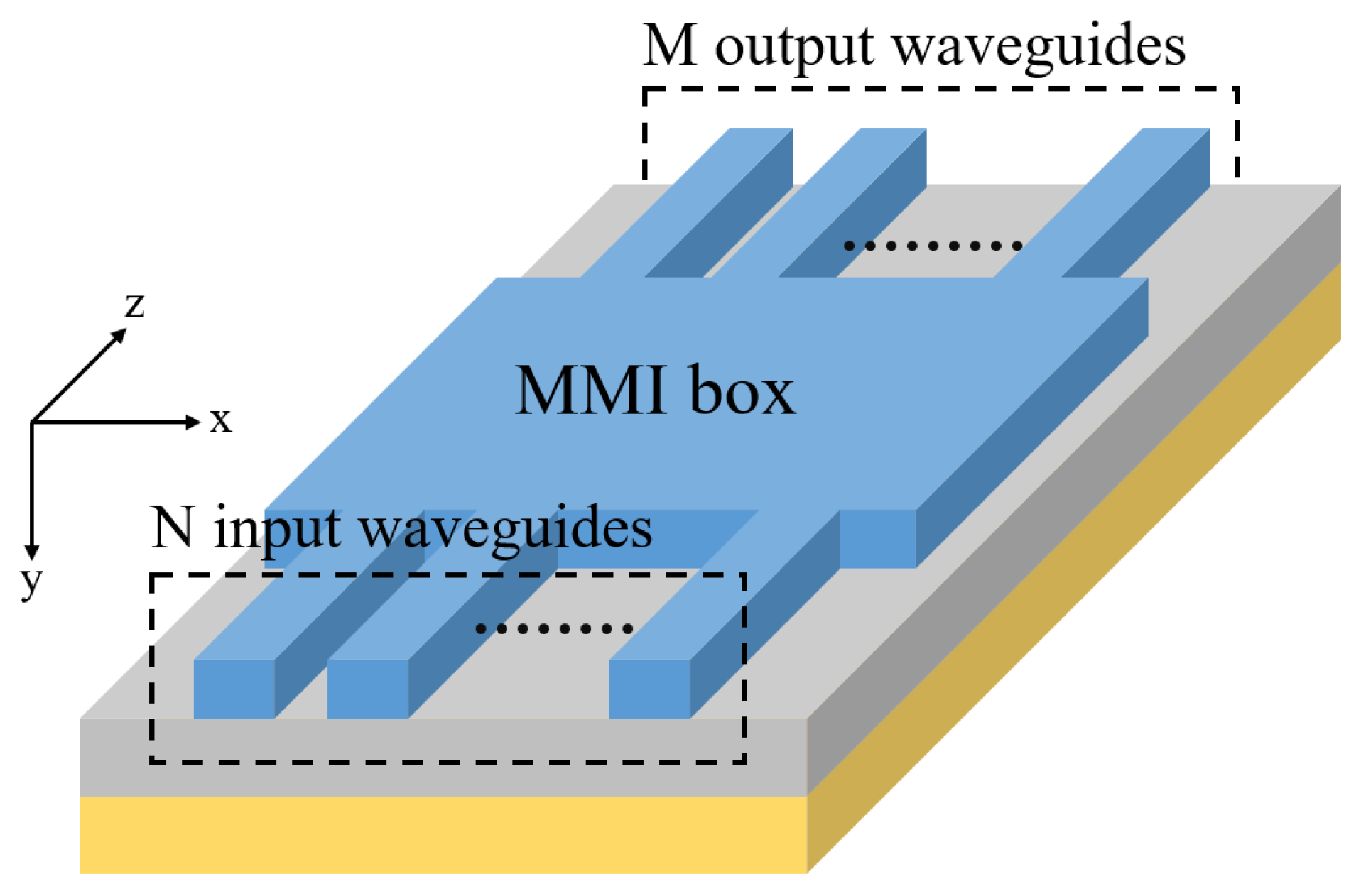

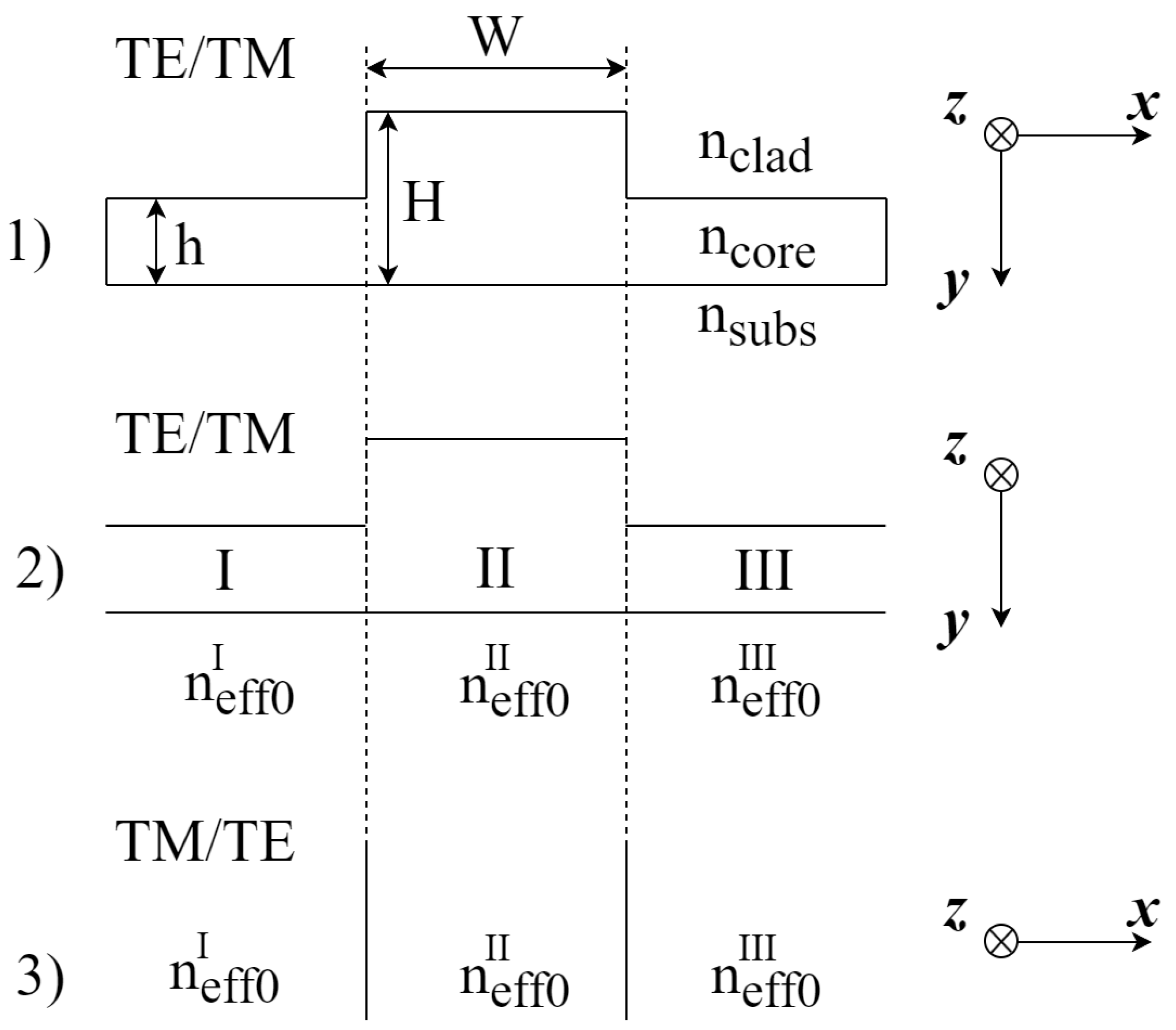

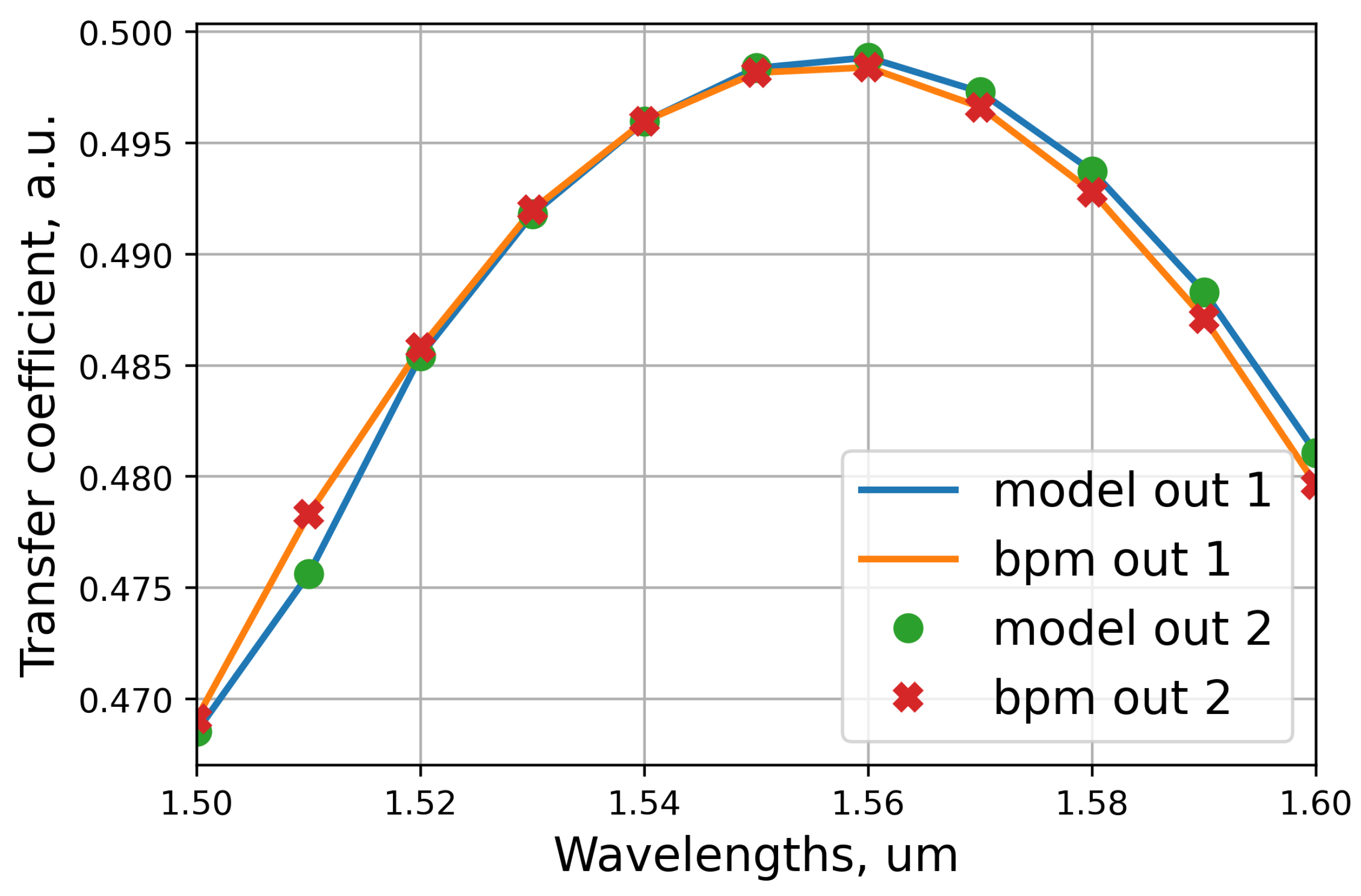


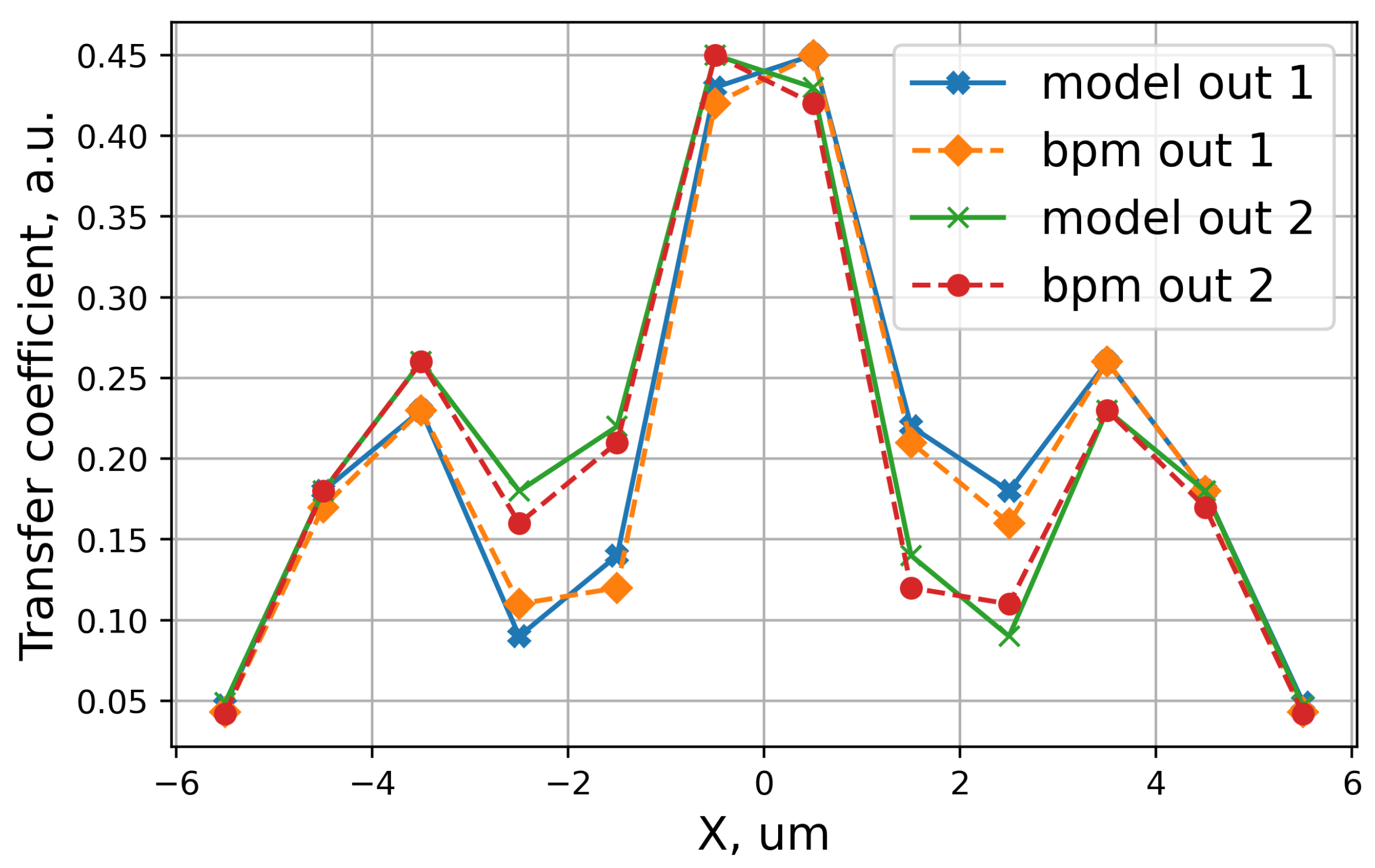
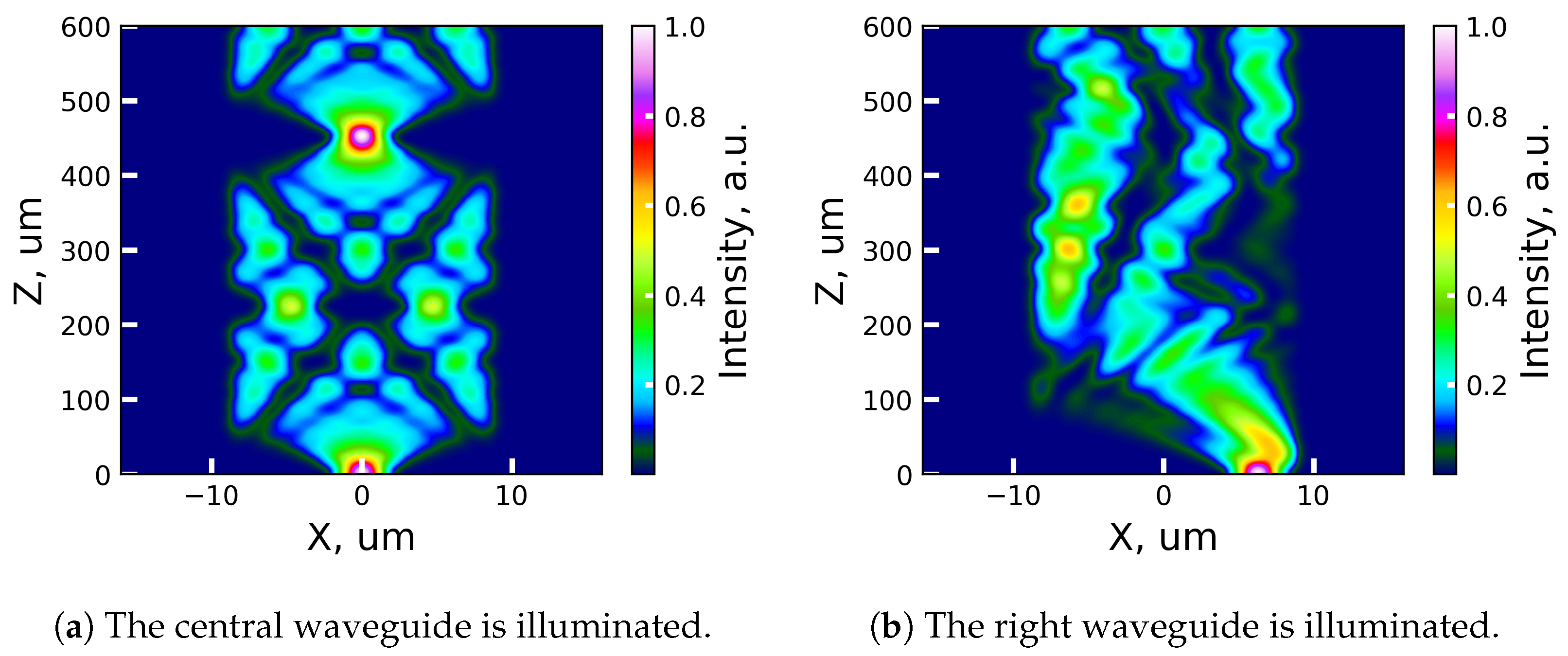
Disclaimer/Publisher’s Note: The statements, opinions and data contained in all publications are solely those of the individual author(s) and contributor(s) and not of MDPI and/or the editor(s). MDPI and/or the editor(s) disclaim responsibility for any injury to people or property resulting from any ideas, methods, instructions or products referred to in the content. |
© 2023 by the authors. Licensee MDPI, Basel, Switzerland. This article is an open access article distributed under the terms and conditions of the Creative Commons Attribution (CC BY) license (https://creativecommons.org/licenses/by/4.0/).
Share and Cite
Moskalev, D.; Kozlov, A.; Salgaeva, U.; Krishtop, V.; Perminov, A.V.; Venediktov, V. A Semi-Analytical Method for the S-Parameter Calculations of an N × M Multimode Interference Coupler. Photonics 2023, 10, 1260. https://doi.org/10.3390/photonics10111260
Moskalev D, Kozlov A, Salgaeva U, Krishtop V, Perminov AV, Venediktov V. A Semi-Analytical Method for the S-Parameter Calculations of an N × M Multimode Interference Coupler. Photonics. 2023; 10(11):1260. https://doi.org/10.3390/photonics10111260
Chicago/Turabian StyleMoskalev, Dmitrii, Andrei Kozlov, Uliana Salgaeva, Victor Krishtop, Anatolii V. Perminov, and Vladimir Venediktov. 2023. "A Semi-Analytical Method for the S-Parameter Calculations of an N × M Multimode Interference Coupler" Photonics 10, no. 11: 1260. https://doi.org/10.3390/photonics10111260
APA StyleMoskalev, D., Kozlov, A., Salgaeva, U., Krishtop, V., Perminov, A. V., & Venediktov, V. (2023). A Semi-Analytical Method for the S-Parameter Calculations of an N × M Multimode Interference Coupler. Photonics, 10(11), 1260. https://doi.org/10.3390/photonics10111260




